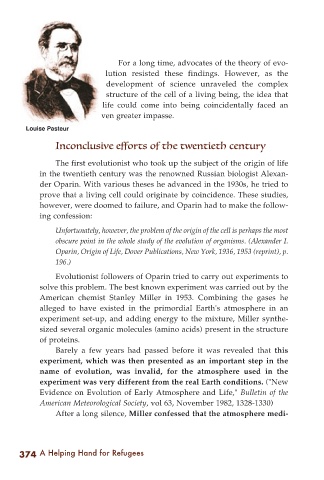Page 376 - A Helping Hand for Refugees
P. 376
For a long time, advocates of the theory of evo-
lution resisted these findings. However, as the
development of science unraveled the complex
structure of the cell of a living being, the idea that
life could come into being coincidentally faced an
even greater impasse.
Louise Pasteur
Inconclusive efforts of the twentieth century
The first evolutionist who took up the subject of the origin of life
in the twentieth century was the renowned Russian biologist Alexan-
der Oparin. With various theses he advanced in the 1930s, he tried to
prove that a living cell could originate by coincidence. These studies,
however, were doomed to failure, and Oparin had to make the follow-
ing confession:
Unfortunately, however, the problem of the origin of the cell is perhaps the most
obscure point in the whole study of the evolution of organisms. (Alexander I.
Oparin, Origin of Life, Dover Publications, New York, 1936, 1953 (reprint), p.
196.)
Evolutionist followers of Oparin tried to carry out experiments to
solve this problem. The best known experiment was carried out by the
American chemist Stanley Miller in 1953. Combining the gases he
alleged to have existed in the primordial Earth's atmosphere in an
experiment set-up, and adding energy to the mixture, Miller synthe-
sized several organic molecules (amino acids) present in the structure
of proteins.
Barely a few years had passed before it was revealed that this
experiment, which was then presented as an important step in the
name of evolution, was invalid, for the atmosphere used in the
experiment was very different from the real Earth conditions. ("New
Evidence on Evolution of Early Atmosphere and Life," Bulletin of the
American Meteorological Society, vol 63, November 1982, 1328-1330)
After a long silence, Miller confessed that the atmosphere medi-
374 A Helping Hand for Refugees

